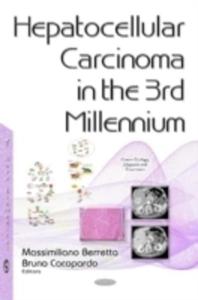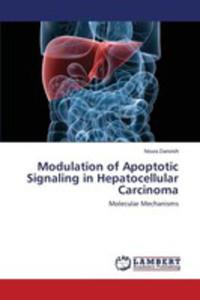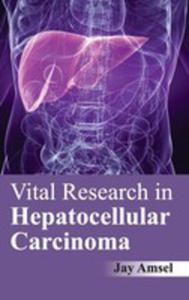libristo hepatocellular carcinoma 1 5184870
- znaleziono 14 produktów w 3 sklepach
Apoptosis Related Proteins P53 And Bcl - 2 In Hepatocellular Carcinoma
Książki Obcojęzyczne>Angielskie>Mathematics & science>Chemistry
0x002e8edd00000000
Sklep: Gigant.pl
Apoptosis Related Proteins P53 And Bcl - 2 In Hepatocellular Carcinoma
Książki Obcojęzyczne>Angielskie>Mathematics & science>Chemistry
0x0030607000000000
Sklep: Gigant.pl
Pathobiology Of Hepatocellular Carcinoma & Clinical Impact
Książki Obcojęzyczne>Angielskie>Medicine>Other branches of medicine>PathologyKsiążki Obcojęzyczne>Angielskie>Medicine>Clinical & ...
0x00bacd2f00000000
Sklep: Gigant.pl
Exploring Systemic Options For Advanced Hepatocellular Carcinoma
Książki Obcojęzyczne>Angielskie>Medicine>Medicine: general issues
0x002d7edb00000000
Sklep: Gigant.pl
Recurrence Of Hepatocellular Carcinoma After Radiofrequency Ablation
Książki Obcojęzyczne>Angielskie>Medicine>Medicine: general issues
0x00d0f25c00000000
Sklep: Gigant.pl
Nitric Oxide Before And After Local Rfa For Hepatocellular Carcinoma
Książki Obcojęzyczne>Angielskie>Medicine>Medicine: general issues
0x0025a7a400000000
Sklep: Gigant.pl
Hepatocellular Carcinoma In The 3rd Millennium
Książki Obcojęzyczne>Angielskie>Medicine>Clinical & internal medicine>Diseases & disorders>Oncology
0x00a5f12400000000
Sklep: Gigant.pl
Cellular Metastasis Of Hepatocellular Carcinoma
Książki Obcojęzyczne>Angielskie>Mathematics & science>Biology, life sciences
0x0034015d00000000
Sklep: Gigant.pl
Modulation Of Apoptotic Signaling In Hepatocellular Carcinoma
Książki Obcojęzyczne>Angielskie>Mathematics & science>Biology, life sciences>Biochemistry
0x0032103900000000
Sklep: Gigant.pl
Modulation Of Apoptotic Signaling In Hepatocellular Carcinoma
Książki Obcojęzyczne>Angielskie>Mathematics & science>Biology, life sciences>Biochemistry
0x00326f1a00000000
Sklep: Gigant.pl
Vital Research In Hepatocellular Carcinoma
Książki Obcojęzyczne>Nieprzypisane
0x00ccb09100000000
Sklep: Gigant.pl
Infections & Human Cancer v.33 Cold Spring Harbor Laboratory Press
Zdrowie, medycyna
In the opening chapter of Infections and Human Cancer, Parkin and colleagues estimate that in 1990 there were 1.2 million new cases of cancer worldwide that were due to infectious agents. This figure accounts for about 15 percent of all cancers. These cases plus the sum of all neoplasms caused by tobacco account for the largest number of preventable cancers in the world. Infectious agents cause almost one fourth of all cancers in developing countries, a reflection of the high carrier rates in these regions for the four agents that cause 90 percent of cancers due to persistent infection: the hepatitis B and C viruses, the human papilloma viruses, and Helicobacter pylori. Microbial carcinogenesis is, for these reasons, a major public health problem. Its solution will require a huge investment of resources, almost all of it by industrialized countries. Moreover, neoplastic diseases evoked by persistent infection are no longer unusual in developed nations, as evidenced by the rising incidence of hepatocellular carcinoma in the United States, the high prevalence of papillomavirus infection among women, and the frequent occurrence of virus-induced cancers, such as Kaposi's sarcoma and B-cell lymphomas, in patients with AIDS. These facts make a compelling argument that physicians everywhere must understand the clinical implications of persistent infection with potentially oncogenic microbes, the advantages and limitations of screening for such infections and the cancers they cause, and the measures that are at hand or will be available to prevent the spread of these organisms. The two books reviewed here survey the epidemiologic evidence linking a variety of microbes to the causation of cancer, analyze the molecular mechanisms of microbial carcinogenesis, and discuss measures to thwart infection-associated cancer. The organisms under scrutiny include the human papillomaviruses, Epstein-Barr virus, human herpesvirus 8 (HHV-8, or Kaposi's sarcoma-associated herpesvirus), hepatitis B and C viruses, human T-cell leukemia virus, schistosoma, liver flukes, H. pylori, and intestinal bacteria. Each book features concise, timely expositions of various aspects of microbial oncogenesis, from descriptions of the culpable organisms to prevention by vaccination. Despite their similarities, these books differ in outlook and tone. For readers seeking a comprehensive review of the problems of infection-related cancer, both are worth examining. Infections and Human Cancer offers 15 surveys of the epidemiology, risk factors, and molecular mechanisms of carcinogenic microorganisms. The review of cancer in patients infected with the human immunodeficiency virus is excellent. A chapter on screening points out that the administration of hepatitis B immunoglobulin to newborns of infected mothers immediately after birth can reduce the carrier rate in children by as much as 90 percent. Presumably, the institution of national or worldwide programs of such prophylactic passive immunization against the hepatitis B virus will ultimately reduce the prevalence of hepatocellular carcinoma. In long-term carriers of the virus, screening with a combination of alpha-fetoprotein measurement and hepatic ultrasonography shows promise in detecting early, surgically resectable tumors. For hepatitis C, unfortunately, there is no effective means of prophylaxis, rendering moot the issue of screening until prevention is practical. Infections and Human Cancer concludes with a chapter on prophylactic and therapeutic vaccination against hepatitis B, human papillomaviruses, and H. pylori. Some of these vaccines are still in developmental stages; if they prove to be safe, effective, and economically feasible, they promise enormous benefits. Parsonnet leads off Microbes and Malignancy with a brief account of the history of the relation between infectious diseases and cancer. She places Leeuwenhoeck, who was born in 1632, in the 19th century and fails to mention Gross's seminal discovery of the mouse leukemia virus. However, she effectively relates how the history of cancer research was marred by false starts (notably Fibiger's mistaken claim that a nematode can cause stomach cancer, for which he was awarded the Nobel prize) and doubts that any organism could cause cancer (Rous had to wait more than 50 years before he was awarded the Nobel prize for his discovery of the chicken sarcoma virus). The first four chapters of Microbes and Malignancy deal with mechanisms of infection-induced cancer. Relman's review of chronic host-parasite interactions has a broad sweep, whereas the chapter on chronic inflammation and cancer focuses narrowly on the role of oxidative damage. Cohen reviews the evidence implicating cell proliferation in the pathogenesis of cancer but says little about DNA repair (defective DNA repair in ataxia-telangiectasia is well covered later by Karp and Blattner) or the chromosomal aberrations that are at least as essential to cell transformation as proliferation. In his excellent chapter on viral oncogenesis, Zur Hausen traces the evolution of cancer from infection with a carcinogenic human papillomavirus, through the loss of the cellular genes required to counteract the growth-promoting effects of papillomavirus oncoproteins, to the escape of the transformed cell from attack by the immune system. Microbes and Malignancy offers thorough reviews of the diseases caused by the Epstein-Barr virus, HHV-8, the hepatitis B and C viruses, H. pylori, and other relevant microbes. For readers interested in other microbial causes of cancer, there are informative reviews of the T-cell leukemia virus, schistosomes, and liver flukes. Robinson points out that, worldwide, only the number of lung cancers due to cigarette smoking exceeds the incidence of hepatocellular carcinoma due to hepatitis B virus. According to Parsonnet, about half the world's population harbors H. pylori, yet in only 1 percent does gastric cancer develop. Gastric lymphoma is even rarer, and it occasionally occurs simultaneously with gastric cancer. Infections and Human Cancer and Microbes and Malignancy are fascinating books, and like all good surveys of scientific matters, they raise profound questions for which there are no immediate answers. A thread running through both books is that despite its immense power to give us a close-up view of how cancer develops, molecular biology cannot show us the big picture. Until we find new ways of looking at the connections between microbes and cancer, we will remain, as Milton said in Comus, 'in the blind mazes of this tangled wood.'
Sklep: Albertus.pl
HI TEC Omega Extreme 120 kaps HI TEC
Suplementy i odżywki>Witaminy
HI TEC Omega Extreme 120 kaps Wielonienasycone kwasy tłuszczowe z serii Omega-3 i Omega-6 wchodzą w skład fosfolipidów budujących błony biologiczne każdej żywej komórki. Na powierzchni błon biologicznych znajdują się niezliczone enzymy, receptory, kanały i pompy jonowe czyli białka warunkujące prawidłowy przebieg procesów metabolicznych w komórce, a ich funkcjonalność i efektywność działania zależy od warunków panujących w błonie. Wielonienasycone kwasy tłuszczowe Omega-3 i Omega-6 regulują płynność błony, a tym samym wspomagają działanie niemal wszystkich białek zagnieżdżonych w dwuwarstwie lipidowej błony komórkowej. Jeśli kwasy tłuszczowe ulegną uwolnieniu z fosfolipidów błony to wykorzystywane są do syntezy lokalnie działających hormonów tkankowych
Sklep: Sport-Max
Sklepy zlokalizowane w miastach: Warszawa, Kraków, Łódź, Wrocław, Poznań, Gdańsk, Szczecin, Bydgoszcz, Lublin, Katowice
Szukaj w sklepach lub całym serwisie
1. Sklepy z libristo pl hepatocellular carcinoma 1 5184870
2. Szukaj na wszystkich stronach serwisu
t1=0.039, t2=0, t3=0, t4=0.013, t=0.039














